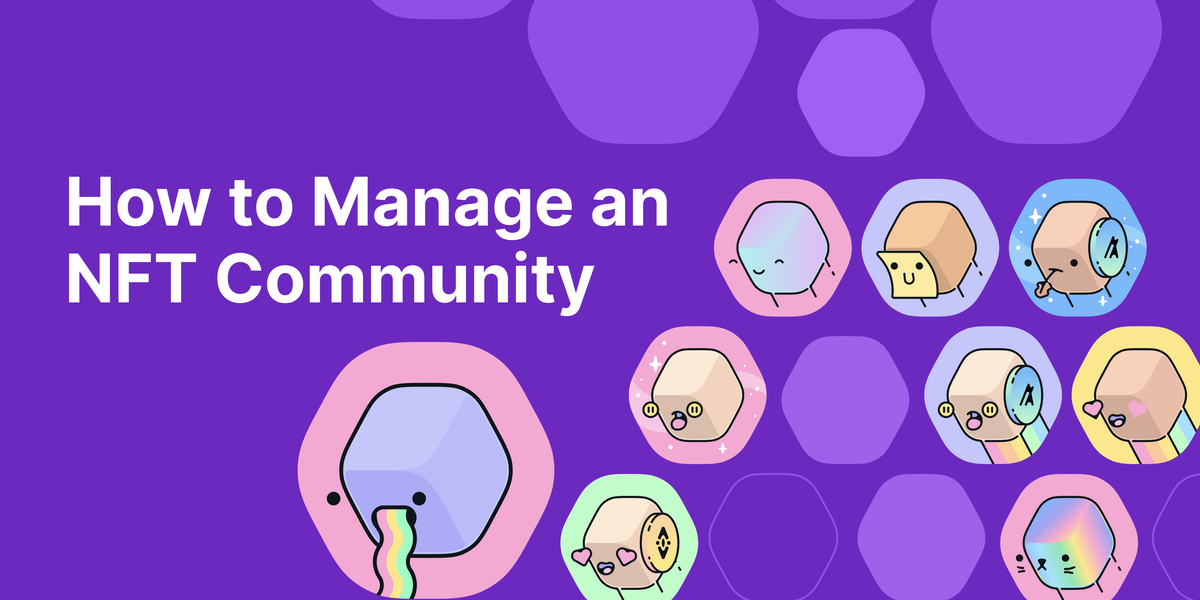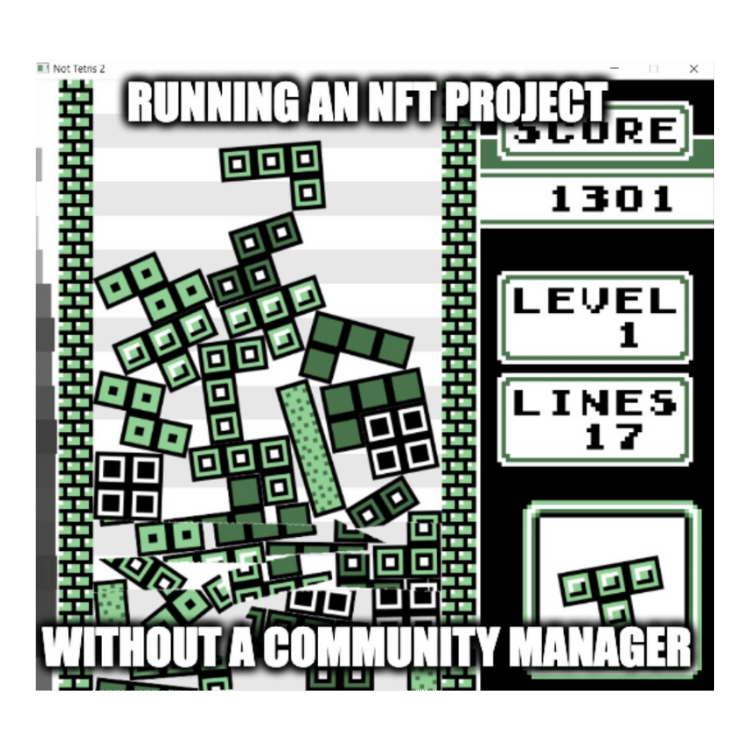How to Manage an NFT Community
From legacy brands like Nike and Starbucks to individual creators, NFTs are here to stay. But not all NFT projects are created equal. Learn the community management strategies that will make your NFT project stand out in a crowded market.

Nowadays, everybody and their dog wants to launch an NFT — your dog's NFT collection is probably better than many of the lazy derivatives we've seen.
Whether it be your college roommate or legacy institutions like Starbucks, Nike, or Reddit, it's clear that NFTs are more than a passing fad.
And for a good reason. NFTs do around a hundred million in weekly sales, and the most valuable web3-native NFT collections like Bored Ape Yacht Club and Cryptopunks are worth an unfathomable amount of money.
We live in a world where web3 is inevitable, and the metaverse may soon be worth $5 trillion. As a result, it would be incredibly shortsighted for legacy brands to refrain from dabbling in NFTs.
However, their success in doing so is debatable. The success rate for brands introducing NFTs is far too low. For every Nike, there are multiple WWEs. Fortunately, the problem is simple: poor community management.
As for the solution, well, that's the focus of this article.
The Importance of the NFT Community
Web3 is a beautiful place full of innovation. Builders throughout the space are developing game-changing protocols in DeFi, NFTs, GameFi, and the metaverse. This is indisputable.
It is also indisputable that web3 is an inefficient market where things that don't make a shred of sense happen with unbelievable frequency.
Look no further for proof than what's happened with Dogecoin: every time Elon tweets anything remotely DOGE related, or better yet, goes on Saturday Night Live, there is a huge pop in price action. Dogecoin. In 2022. We all thought Dogecoin was just a thing to do while bored during COVID, but apparently not.
The NFT market is especially notorious for being wonky. What moons and what doesn't seems to be completely random. The best example of this occurred over the summer with the Goblins. Somehow, this collection of literal goblins rocketed to >25 ETH off the back of a Twitter space where grown men made goblin sounds for 3 hours. If you have yet to hear the audio, consider yourself lucky.
Now, what do the stories of Dogecoin and Goblins have in common? They mooned because they have a rabid and dedicated community that will press the buy button even when it doesn't really make sense to do so.
At the most basic level, an NFT increases in value when demand is greater than supply. So, you need more buyers than sellers. What is the best way to get more buyers? Grow a larger and stronger community.
This is what too many new NFT brands ignore. It doesn't matter how fantastic your art is or what benefits the NFTs give; if the community doesn't rally around it, the price will not go up. Period.
Web3 is different from the legacy web2 world. In the traditional world, the product and product-market fit is often the most critical factor for success. For web3, and especially with NFTs, it is an attention economy. The projects that succeed are the ones that capture the most attention, irrespective of their product.
Let's now talk about how you can win in the attention economy.

Maximize Social Media
The absolute best thing you can do for your NFT collection is to build something cool and worthy of being bought. The next best thing is to fully maximize social media.
Web3 is a digital game. NFT buyers exist online. They aren't in stores but on Twitter, Discord, and Telegram. So you, the NFT brand, must make a concentrated effort to reach these people.
You may be reading that and thinking, "ok, cool, I'll send out a tweet or two about our NFT collection on our main account." No. Just no. That's not good enough.
You need to have a Twitter dedicated to the NFT, constantly pumping out content. You need to be posting memes. You need to have a Discord jumping with activity, and a Telegram just as busy.
When you pour time and energy into creating content for your community, your community will start making content for you: memes, tweets, etc. There's a reason why brands like GoPro, Snapchat, and more love user-generated content. It's free. And having users as evangelists for your brand is a dream come true.
Remember, this is an attention game. If you don't do everything in your power to grab the very limited attention of the NFT community, then somebody else will.
If you get behind the 8-ball, you'll never get ahead.
these are the vibes heading into 2023 pic.twitter.com/sTSl9BgtFE
— icy.tools - NFT Tracking & Alerts (@icy_tools) October 25, 2022
Hire a Community Manager
If you had a moment of existential crisis after you read the previous section, good, because you should have. To do social media right requires an amount of work that the founding team just doesn't have.
Which is why you need to hire a community manager. And not just any community manager, but a good one.
What makes a good community manager? Well, in large part, it is determined by results. However, there are some common traits among the best community managers:
- Able to craft a story and narrative: The best NFTs have a narrative behind them. Just look at the Goblins: an NFT that brings to life "goblin-town." Your community manager should be able to identify what will get the community to identify with your project and then be able to convey it effectively.
- A master of communication: Strong NFT communities are driven by community managers constantly engaging with it. This means that community managers need to banter in Discord, make funny memes for Twitter, secure partnerships with other brands, and host Twitter spaces with influencers to boost the project's reach.
- Endlessly dedicated: Building a large community is not an easy overnight process. It requires hours and hours of work from all involved. To be a community manager means to be somebody fully dedicated to the process.
The key thing about good community managers is that the skills are mostly unlearnable. You can't really learn how to be personable, friendly, patient, or funny. Make sure whoever you hire already has these traits. If they don't, you're best off going elsewhere.

Leverage the Power of Memes
As we've established, building a large NFT community primarily depends on your ability to go viral and capture people's attention. So, how do you go viral on NFT Twitter?
Memes. Good ones.
Why are memes so important? Because memes are a core part of storytelling. They are largely how people on NFT Twitter get their message across, and they do so pretty damn effectively.
A well-placed meme goes a long way toward building a strong community.
Just look at the largest NFT communities. There's a reason that everybody knows what Bored Apes, CryptoPunks, Azuki, Goblins, Cool Cats, and Miladys are. Are they the projects with the best art? Definitely not. Do they give the best benefits and have the most use cases? Nope. Are they all extremely meme-able? You bet.
At the end of the day, you're creating JPEGs on the internet. Take that extra step and work on your meme game.
Don't Forget Reliable NFT Infrastructure
An often overlooked factor of overall community happiness is reliability and technical support for your NFT collection. Don't drop the ball when supporting your project on the back end. Start with a smooth mint day and keep your eyes forward on growing and creating.
With QuickNode, NFT projects can easily set up a node in seconds and have it fully synced with the blockchain, eliminating the need for technical expertise or allocating resources to maintain the node. QuickNode also has some stellar, elastic APIs, which allow its nodes to handle any number of requests, ensuring your infrastructure can handle high demand during NFT sales. So keep your focus on marketing, community building, and content creation while still having the reliable infrastructure needed to run your NFT project successfully.
Final Thoughts
Ultimately, your biggest takeaway from this article should be that web3 is not web2. It sounds obvious, but then you realize that many people are still trying to port web2 strategies over to web3. You will not be able to release a press statement, run a few ads, tweet a few tweets, and have a large NFT community. Likewise, you need to do more than just grind until your tongue hits the floor.
Success in NFT community building is like a dance. The NFT community is harsh and loses interest quickly, but they are fiercely loyal if you can hook them on. You need to constantly interact with them, develop new ideas, post memes, and do whatever you can to make them feel like they are a part of the NFT's success. That is how you build a loyal and strong community.
So, fully commit to social media, hire a good community manager, tighten up your meme game, and be prepared to put in many hours.
The reward for doing so is worth it.

About QuickNode
QuickNode is building infrastructure to support the future of Web3. Since 2017, we've worked with hundreds of developers and companies, helping scale dApps and providing high-performance access to 16+ blockchains. Subscribe to our newsletter for more content like this and stay in the loop with what's happening in Web3!





